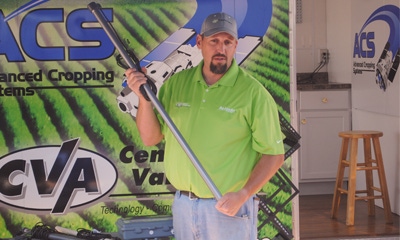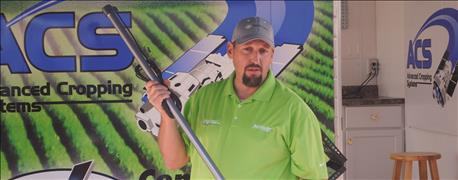
As the growing season draws to a close, many producers wonder where their soil moisture probes are paying off the most. Should they place their probes in corn or soybean fields for the most return on their investment of money and time? Most producers place a few probes in soybean fields, but focus more on cornfields. So, the answer to that question probably depends on who you ask to answer it. There are two schools of thought.

CORN OR BEANS: Keith Byerly, Central Valley Ag Advanced Cropping Systems manager, discusses placement of soil moisture probes at a recent field tour of the Bazile Groundwater Management Area.
Keith Byerly manages the Advanced Cropping Systems team for Central Valley Ag and has a wealth of experience at soil moisture probe placement. "It is definitely more exciting, and you get more management opportunities and more irrigation opportunities with corn," Byerly told a group of producers at a recent Bazile Groundwater Management Area field tour. "Watching the data on corn is more interesting because there is more going on. You might water corn up to 13 inches or more during the season, depending on the need."
By early August of this season, Byerly reported that some producers using probes had saved up to 2.7 inches of irrigation water, with no noticeable difference in corn yield potential.
"You just don't want to stress the corn crop," says Brandon Christiansen, who hosted the field tour stop at his farm near Plainview. "You want to focus on the tougher areas in the field, because if you take care of those areas, the rest will be good."
Using data from soil moisture probes is an educational process, but it really pays off in corn, Christiansen says. "Sometimes you use the data more, and sometimes you use it less," he says. "You still need to get out in the field and manually probe the soil to check conditions."
However, Byerly believes that there is the most potential for irrigation management improvements by using probes in soybeans. "You might only be watering very early and late into the growing season on soybeans, and using only 5 to 6 inches of water," Byerly says. "But the timing of those irrigation treatments is so crucial to yield." Irrigating later in the season on soybeans adds yield and improves overall plant health, Byerly says.
"Another big thing about following the moisture probe data is peer pressure," he says. "It is tough not irrigating when everyone else is watering, or to irrigate when everyone else is shut down, because of what the probes are telling you." Gaining confidence in the probes and the data they are giving the producer is the key to getting the most from this management tool, he says.
You can learn more by going online at cvacoop.com/agronomy.
About the Author(s)
You May Also Like






